Financial Performance Analysis Report: Tesco Company Overview
VerifiedAdded on 2023/01/03
|6
|1517
|42
Report
AI Summary
This report provides a comprehensive financial analysis of the Tesco Company, evaluating its performance over the last three financial years. It examines key financial statements, including the trading account, income statement, and balance sheet, to assess the company's profitability, liquidity, and financial structure. The analysis covers net profit margins, gross profit ratios, asset turnover, and debtor turnover, highlighting trends and areas of improvement. The report notes that Tesco's net profit margin improved in the latest financial year, while gross profit margins showed fluctuations. The analysis also points out the reduced asset utilization and increasing debtor turnover ratio, which impacts the company's liquidity. The report concludes with an overall assessment of Tesco's improved financial structure, emphasizing the importance of effective decision-making and control over debtors to enhance financial performance.

mentioned on brief Tesco
Table of Contents
Table of Contents
Secure Best Marks with AI Grader
Need help grading? Try our AI Grader for instant feedback on your assignments.
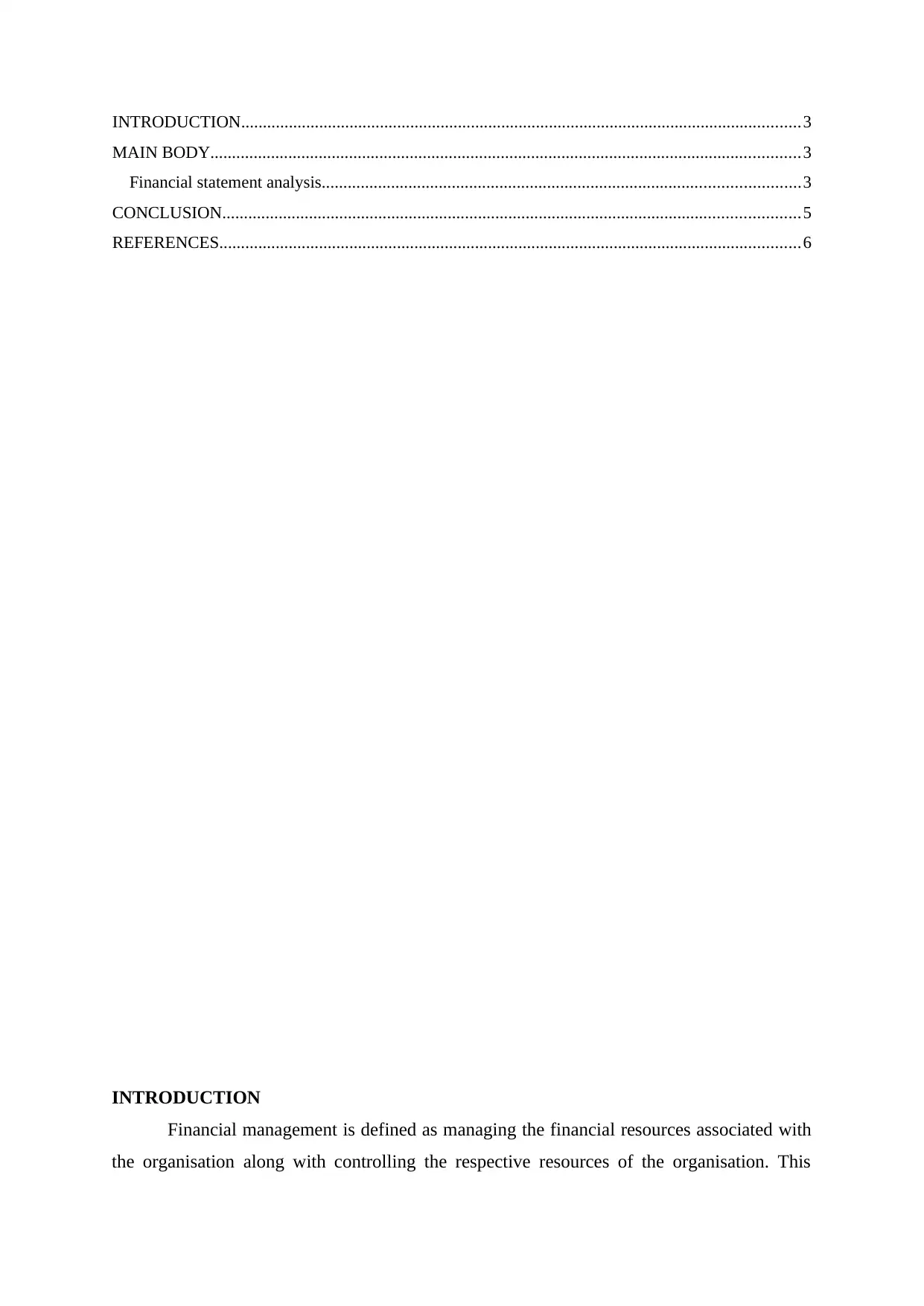
INTRODUCTION.................................................................................................................................3
MAIN BODY........................................................................................................................................3
Financial statement analysis..............................................................................................................3
CONCLUSION.....................................................................................................................................5
REFERENCES......................................................................................................................................6
INTRODUCTION
Financial management is defined as managing the financial resources associated with
the organisation along with controlling the respective resources of the organisation. This
MAIN BODY........................................................................................................................................3
Financial statement analysis..............................................................................................................3
CONCLUSION.....................................................................................................................................5
REFERENCES......................................................................................................................................6
INTRODUCTION
Financial management is defined as managing the financial resources associated with
the organisation along with controlling the respective resources of the organisation. This
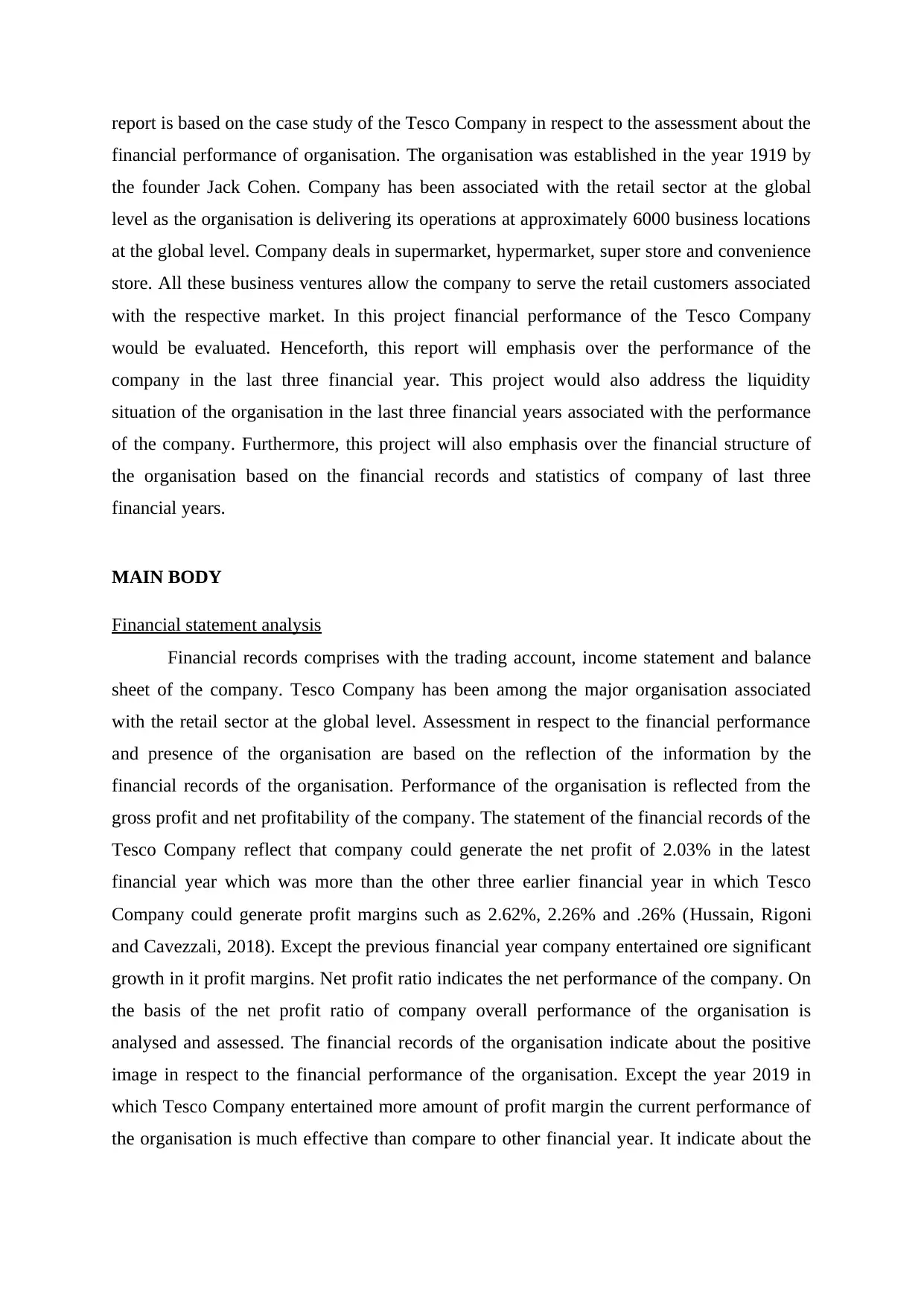
report is based on the case study of the Tesco Company in respect to the assessment about the
financial performance of organisation. The organisation was established in the year 1919 by
the founder Jack Cohen. Company has been associated with the retail sector at the global
level as the organisation is delivering its operations at approximately 6000 business locations
at the global level. Company deals in supermarket, hypermarket, super store and convenience
store. All these business ventures allow the company to serve the retail customers associated
with the respective market. In this project financial performance of the Tesco Company
would be evaluated. Henceforth, this report will emphasis over the performance of the
company in the last three financial year. This project would also address the liquidity
situation of the organisation in the last three financial years associated with the performance
of the company. Furthermore, this project will also emphasis over the financial structure of
the organisation based on the financial records and statistics of company of last three
financial years.
MAIN BODY
Financial statement analysis
Financial records comprises with the trading account, income statement and balance
sheet of the company. Tesco Company has been among the major organisation associated
with the retail sector at the global level. Assessment in respect to the financial performance
and presence of the organisation are based on the reflection of the information by the
financial records of the organisation. Performance of the organisation is reflected from the
gross profit and net profitability of the company. The statement of the financial records of the
Tesco Company reflect that company could generate the net profit of 2.03% in the latest
financial year which was more than the other three earlier financial year in which Tesco
Company could generate profit margins such as 2.62%, 2.26% and .26% (Hussain, Rigoni
and Cavezzali, 2018). Except the previous financial year company entertained ore significant
growth in it profit margins. Net profit ratio indicates the net performance of the company. On
the basis of the net profit ratio of company overall performance of the organisation is
analysed and assessed. The financial records of the organisation indicate about the positive
image in respect to the financial performance of the organisation. Except the year 2019 in
which Tesco Company entertained more amount of profit margin the current performance of
the organisation is much effective than compare to other financial year. It indicate about the
financial performance of organisation. The organisation was established in the year 1919 by
the founder Jack Cohen. Company has been associated with the retail sector at the global
level as the organisation is delivering its operations at approximately 6000 business locations
at the global level. Company deals in supermarket, hypermarket, super store and convenience
store. All these business ventures allow the company to serve the retail customers associated
with the respective market. In this project financial performance of the Tesco Company
would be evaluated. Henceforth, this report will emphasis over the performance of the
company in the last three financial year. This project would also address the liquidity
situation of the organisation in the last three financial years associated with the performance
of the company. Furthermore, this project will also emphasis over the financial structure of
the organisation based on the financial records and statistics of company of last three
financial years.
MAIN BODY
Financial statement analysis
Financial records comprises with the trading account, income statement and balance
sheet of the company. Tesco Company has been among the major organisation associated
with the retail sector at the global level. Assessment in respect to the financial performance
and presence of the organisation are based on the reflection of the information by the
financial records of the organisation. Performance of the organisation is reflected from the
gross profit and net profitability of the company. The statement of the financial records of the
Tesco Company reflect that company could generate the net profit of 2.03% in the latest
financial year which was more than the other three earlier financial year in which Tesco
Company could generate profit margins such as 2.62%, 2.26% and .26% (Hussain, Rigoni
and Cavezzali, 2018). Except the previous financial year company entertained ore significant
growth in it profit margins. Net profit ratio indicates the net performance of the company. On
the basis of the net profit ratio of company overall performance of the organisation is
analysed and assessed. The financial records of the organisation indicate about the positive
image in respect to the financial performance of the organisation. Except the year 2019 in
which Tesco Company entertained more amount of profit margin the current performance of
the organisation is much effective than compare to other financial year. It indicate about the
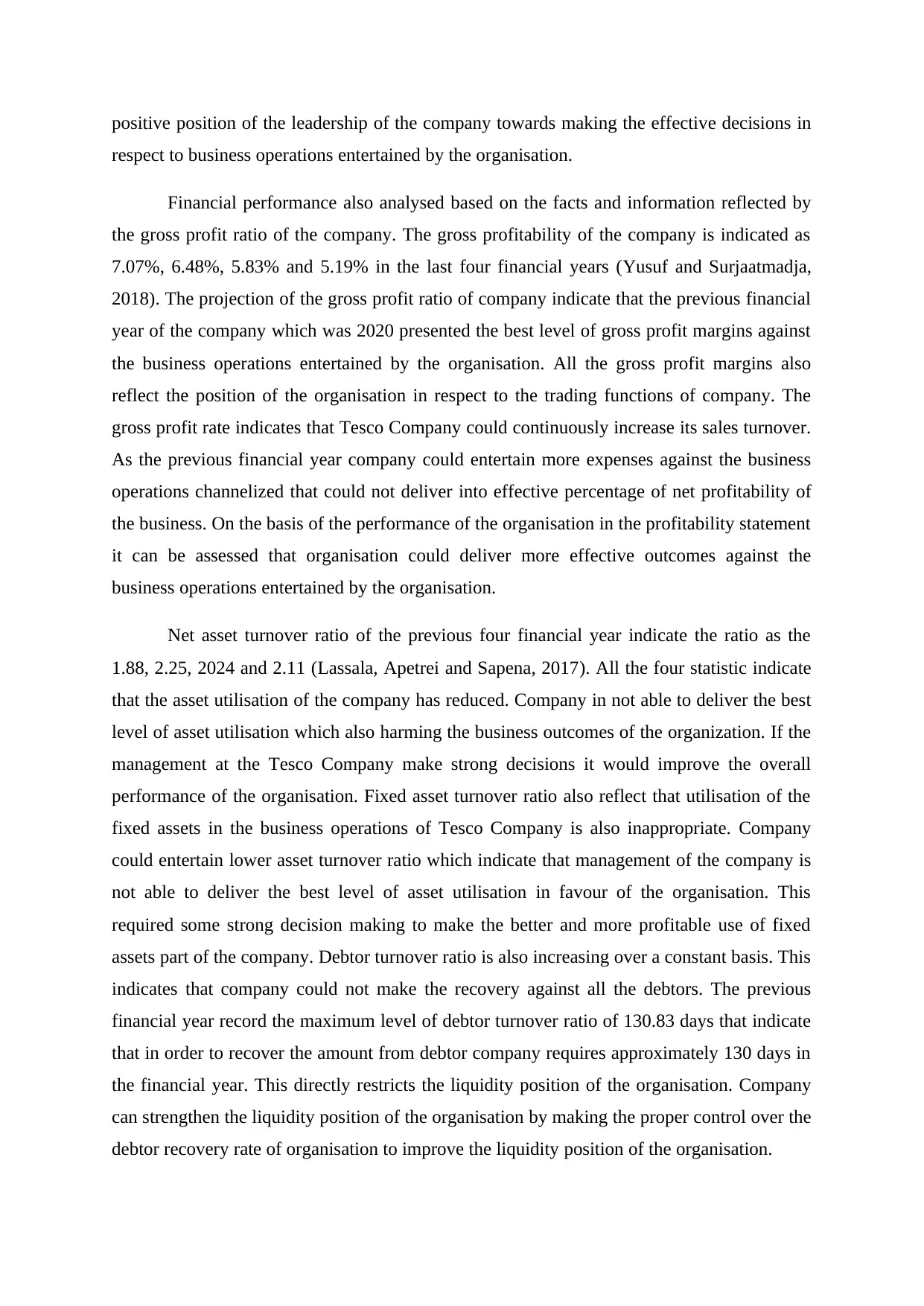
positive position of the leadership of the company towards making the effective decisions in
respect to business operations entertained by the organisation.
Financial performance also analysed based on the facts and information reflected by
the gross profit ratio of the company. The gross profitability of the company is indicated as
7.07%, 6.48%, 5.83% and 5.19% in the last four financial years (Yusuf and Surjaatmadja,
2018). The projection of the gross profit ratio of company indicate that the previous financial
year of the company which was 2020 presented the best level of gross profit margins against
the business operations entertained by the organisation. All the gross profit margins also
reflect the position of the organisation in respect to the trading functions of company. The
gross profit rate indicates that Tesco Company could continuously increase its sales turnover.
As the previous financial year company could entertain more expenses against the business
operations channelized that could not deliver into effective percentage of net profitability of
the business. On the basis of the performance of the organisation in the profitability statement
it can be assessed that organisation could deliver more effective outcomes against the
business operations entertained by the organisation.
Net asset turnover ratio of the previous four financial year indicate the ratio as the
1.88, 2.25, 2024 and 2.11 (Lassala, Apetrei and Sapena, 2017). All the four statistic indicate
that the asset utilisation of the company has reduced. Company in not able to deliver the best
level of asset utilisation which also harming the business outcomes of the organization. If the
management at the Tesco Company make strong decisions it would improve the overall
performance of the organisation. Fixed asset turnover ratio also reflect that utilisation of the
fixed assets in the business operations of Tesco Company is also inappropriate. Company
could entertain lower asset turnover ratio which indicate that management of the company is
not able to deliver the best level of asset utilisation in favour of the organisation. This
required some strong decision making to make the better and more profitable use of fixed
assets part of the company. Debtor turnover ratio is also increasing over a constant basis. This
indicates that company could not make the recovery against all the debtors. The previous
financial year record the maximum level of debtor turnover ratio of 130.83 days that indicate
that in order to recover the amount from debtor company requires approximately 130 days in
the financial year. This directly restricts the liquidity position of the organisation. Company
can strengthen the liquidity position of the organisation by making the proper control over the
debtor recovery rate of organisation to improve the liquidity position of the organisation.
respect to business operations entertained by the organisation.
Financial performance also analysed based on the facts and information reflected by
the gross profit ratio of the company. The gross profitability of the company is indicated as
7.07%, 6.48%, 5.83% and 5.19% in the last four financial years (Yusuf and Surjaatmadja,
2018). The projection of the gross profit ratio of company indicate that the previous financial
year of the company which was 2020 presented the best level of gross profit margins against
the business operations entertained by the organisation. All the gross profit margins also
reflect the position of the organisation in respect to the trading functions of company. The
gross profit rate indicates that Tesco Company could continuously increase its sales turnover.
As the previous financial year company could entertain more expenses against the business
operations channelized that could not deliver into effective percentage of net profitability of
the business. On the basis of the performance of the organisation in the profitability statement
it can be assessed that organisation could deliver more effective outcomes against the
business operations entertained by the organisation.
Net asset turnover ratio of the previous four financial year indicate the ratio as the
1.88, 2.25, 2024 and 2.11 (Lassala, Apetrei and Sapena, 2017). All the four statistic indicate
that the asset utilisation of the company has reduced. Company in not able to deliver the best
level of asset utilisation which also harming the business outcomes of the organization. If the
management at the Tesco Company make strong decisions it would improve the overall
performance of the organisation. Fixed asset turnover ratio also reflect that utilisation of the
fixed assets in the business operations of Tesco Company is also inappropriate. Company
could entertain lower asset turnover ratio which indicate that management of the company is
not able to deliver the best level of asset utilisation in favour of the organisation. This
required some strong decision making to make the better and more profitable use of fixed
assets part of the company. Debtor turnover ratio is also increasing over a constant basis. This
indicates that company could not make the recovery against all the debtors. The previous
financial year record the maximum level of debtor turnover ratio of 130.83 days that indicate
that in order to recover the amount from debtor company requires approximately 130 days in
the financial year. This directly restricts the liquidity position of the organisation. Company
can strengthen the liquidity position of the organisation by making the proper control over the
debtor recovery rate of organisation to improve the liquidity position of the organisation.
Secure Best Marks with AI Grader
Need help grading? Try our AI Grader for instant feedback on your assignments.
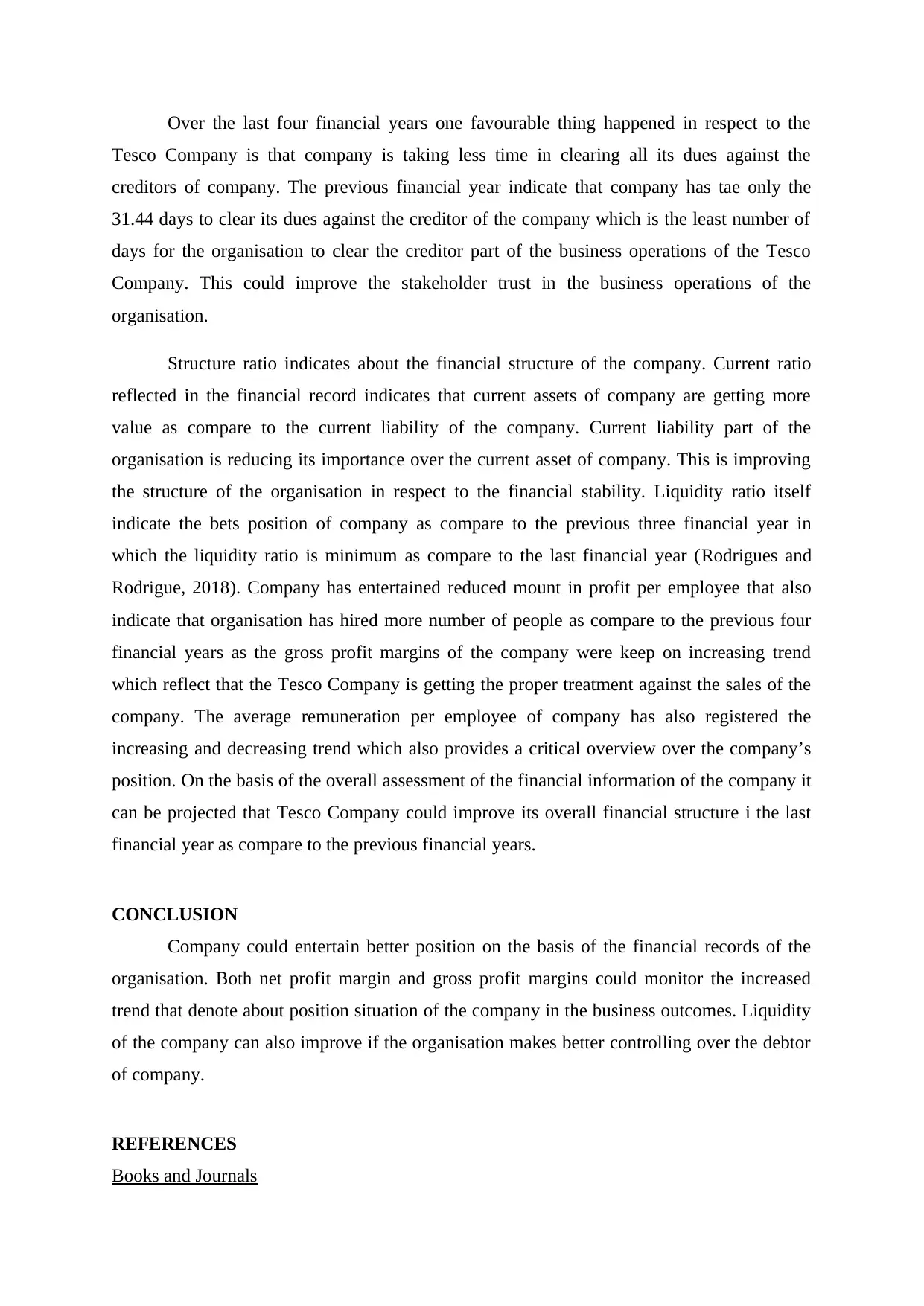
Over the last four financial years one favourable thing happened in respect to the
Tesco Company is that company is taking less time in clearing all its dues against the
creditors of company. The previous financial year indicate that company has tae only the
31.44 days to clear its dues against the creditor of the company which is the least number of
days for the organisation to clear the creditor part of the business operations of the Tesco
Company. This could improve the stakeholder trust in the business operations of the
organisation.
Structure ratio indicates about the financial structure of the company. Current ratio
reflected in the financial record indicates that current assets of company are getting more
value as compare to the current liability of the company. Current liability part of the
organisation is reducing its importance over the current asset of company. This is improving
the structure of the organisation in respect to the financial stability. Liquidity ratio itself
indicate the bets position of company as compare to the previous three financial year in
which the liquidity ratio is minimum as compare to the last financial year (Rodrigues and
Rodrigue, 2018). Company has entertained reduced mount in profit per employee that also
indicate that organisation has hired more number of people as compare to the previous four
financial years as the gross profit margins of the company were keep on increasing trend
which reflect that the Tesco Company is getting the proper treatment against the sales of the
company. The average remuneration per employee of company has also registered the
increasing and decreasing trend which also provides a critical overview over the company’s
position. On the basis of the overall assessment of the financial information of the company it
can be projected that Tesco Company could improve its overall financial structure i the last
financial year as compare to the previous financial years.
CONCLUSION
Company could entertain better position on the basis of the financial records of the
organisation. Both net profit margin and gross profit margins could monitor the increased
trend that denote about position situation of the company in the business outcomes. Liquidity
of the company can also improve if the organisation makes better controlling over the debtor
of company.
REFERENCES
Books and Journals
Tesco Company is that company is taking less time in clearing all its dues against the
creditors of company. The previous financial year indicate that company has tae only the
31.44 days to clear its dues against the creditor of the company which is the least number of
days for the organisation to clear the creditor part of the business operations of the Tesco
Company. This could improve the stakeholder trust in the business operations of the
organisation.
Structure ratio indicates about the financial structure of the company. Current ratio
reflected in the financial record indicates that current assets of company are getting more
value as compare to the current liability of the company. Current liability part of the
organisation is reducing its importance over the current asset of company. This is improving
the structure of the organisation in respect to the financial stability. Liquidity ratio itself
indicate the bets position of company as compare to the previous three financial year in
which the liquidity ratio is minimum as compare to the last financial year (Rodrigues and
Rodrigue, 2018). Company has entertained reduced mount in profit per employee that also
indicate that organisation has hired more number of people as compare to the previous four
financial years as the gross profit margins of the company were keep on increasing trend
which reflect that the Tesco Company is getting the proper treatment against the sales of the
company. The average remuneration per employee of company has also registered the
increasing and decreasing trend which also provides a critical overview over the company’s
position. On the basis of the overall assessment of the financial information of the company it
can be projected that Tesco Company could improve its overall financial structure i the last
financial year as compare to the previous financial years.
CONCLUSION
Company could entertain better position on the basis of the financial records of the
organisation. Both net profit margin and gross profit margins could monitor the increased
trend that denote about position situation of the company in the business outcomes. Liquidity
of the company can also improve if the organisation makes better controlling over the debtor
of company.
REFERENCES
Books and Journals
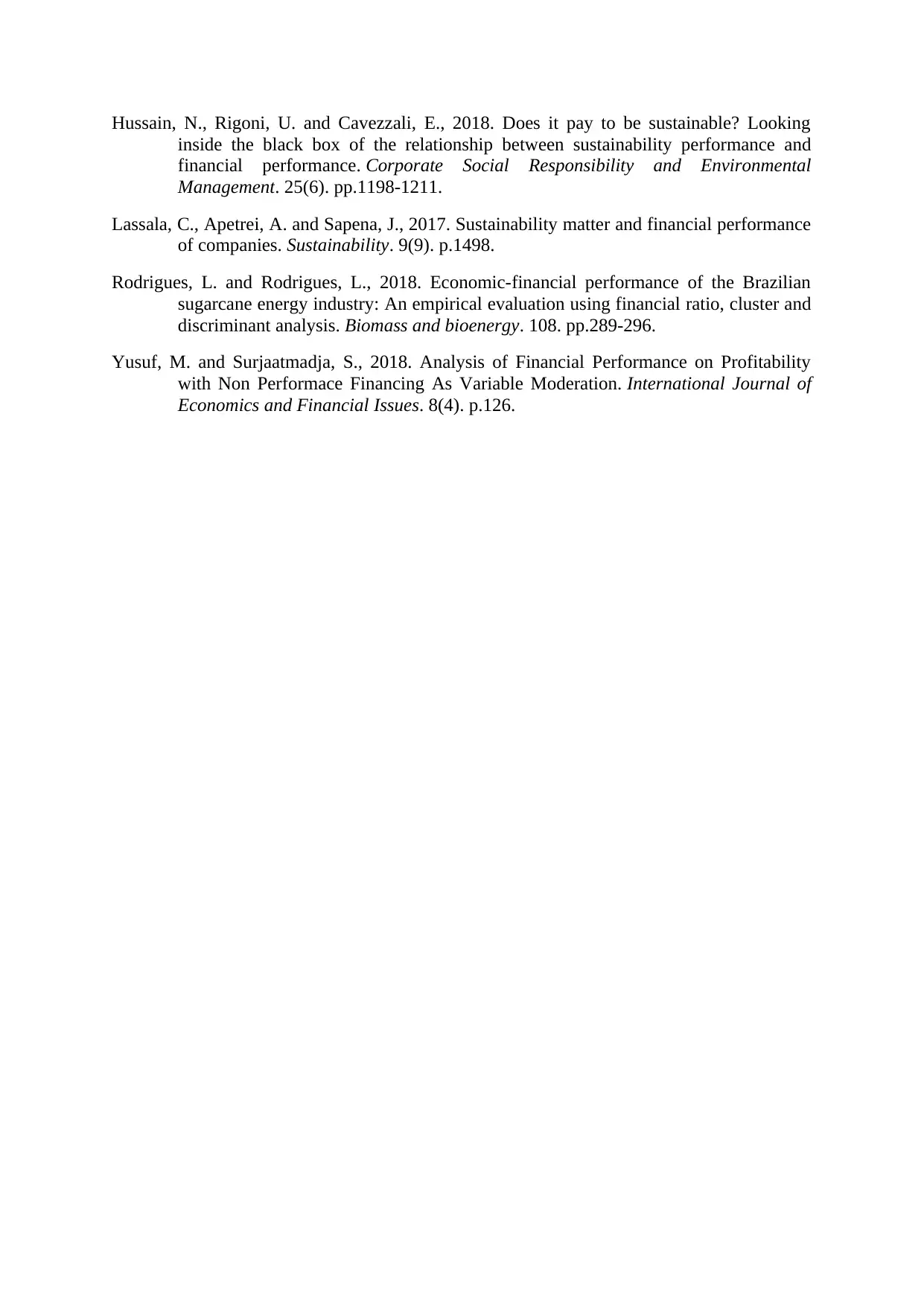
Hussain, N., Rigoni, U. and Cavezzali, E., 2018. Does it pay to be sustainable? Looking
inside the black box of the relationship between sustainability performance and
financial performance. Corporate Social Responsibility and Environmental
Management. 25(6). pp.1198-1211.
Lassala, C., Apetrei, A. and Sapena, J., 2017. Sustainability matter and financial performance
of companies. Sustainability. 9(9). p.1498.
Rodrigues, L. and Rodrigues, L., 2018. Economic-financial performance of the Brazilian
sugarcane energy industry: An empirical evaluation using financial ratio, cluster and
discriminant analysis. Biomass and bioenergy. 108. pp.289-296.
Yusuf, M. and Surjaatmadja, S., 2018. Analysis of Financial Performance on Profitability
with Non Performace Financing As Variable Moderation. International Journal of
Economics and Financial Issues. 8(4). p.126.
inside the black box of the relationship between sustainability performance and
financial performance. Corporate Social Responsibility and Environmental
Management. 25(6). pp.1198-1211.
Lassala, C., Apetrei, A. and Sapena, J., 2017. Sustainability matter and financial performance
of companies. Sustainability. 9(9). p.1498.
Rodrigues, L. and Rodrigues, L., 2018. Economic-financial performance of the Brazilian
sugarcane energy industry: An empirical evaluation using financial ratio, cluster and
discriminant analysis. Biomass and bioenergy. 108. pp.289-296.
Yusuf, M. and Surjaatmadja, S., 2018. Analysis of Financial Performance on Profitability
with Non Performace Financing As Variable Moderation. International Journal of
Economics and Financial Issues. 8(4). p.126.
1 out of 6
Related Documents
Your All-in-One AI-Powered Toolkit for Academic Success.
+13062052269
info@desklib.com
Available 24*7 on WhatsApp / Email
![[object Object]](/_next/static/media/star-bottom.7253800d.svg)
Unlock your academic potential
© 2024 | Zucol Services PVT LTD | All rights reserved.





